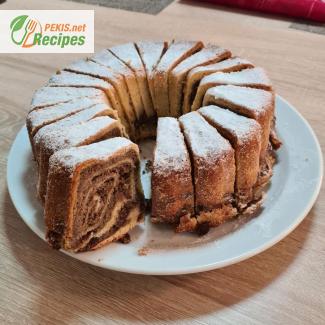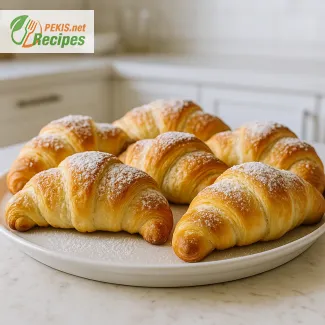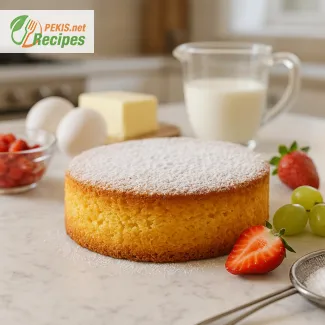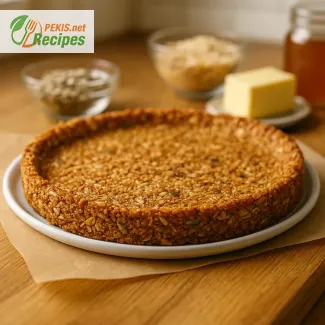
Discover the Rich Tradition Behind Slovenia’s Most Beloved Festive Dessert
A timeless European walnut roll with deep cultural roots and irresistible flavor
There are few desserts in the world that carry the warmth, history, and celebration quite like the Slovenian potica. This exquisite walnut roll is not just a sweet treat—it is a symbol of heritage, hospitality, and the joy of gathering around the table with loved ones. Whether you first encountered potica on a festive Easter table, at a traditional Slovenian wedding, or in the cozy kitchen of a grandmother’s home, its tender dough and fragrant filling are unforgettable.
This beloved Slovenian dessert has found a cherished place in kitchens across Europe and beyond. With its spiraled interior of sweet nut filling, buttery pastry, and rich, earthy aromas, potica embodies centuries of culinary artistry. Yet despite its refined appearance, this recipe is all about home. It’s about baking with love, taking your time, and sharing something beautiful that brings people together.
What sets potica apart from other nut rolls is its uniquely Slovenian identity. The recipe is deeply tied to the country’s rural traditions, religious customs, and family celebrations. In Slovenian homes, it’s often baked during Easter and Christmas, and it varies slightly by region and family tradition. The most popular version features ground walnuts sweetened with honey or sugar and enhanced with a hint of cinnamon and vanilla, all lovingly rolled into a soft, yeasted dough.
For many Slovenians, making potica is a sacred ritual—something passed from generation to generation. But even if you didn’t grow up with it, there’s something universally comforting and satisfying about this classic European bake. Whether you’re an avid baker or someone looking to explore new cultural flavors, this recipe will walk you through every step needed to master an authentic homemade walnut potica.
Potica is traditionally baked in a fluted ring mold, giving it a signature round shape that slices into stunning spirals. The texture is tender yet structured, balancing the slightly chewy crumb of the dough with the creamy richness of the filling. With each bite, you’ll enjoy layers of subtle sweetness, nutty depth, and the gentle tang of a slow-risen dough.
From its modest Slovenian origins, potica has grown into a globally recognized dessert, even making an appearance at the Vatican and being honored during visits from world leaders. Yet it remains beautifully unpretentious—made with simple ingredients and a lot of heart.
Whether you’re preparing a special holiday dessert, a centerpiece for your Easter brunch, or simply a weekend baking project to reconnect with your roots (or create new ones), potica is the perfect choice. Its inviting aroma will fill your kitchen, and its taste will linger in memory long after the last crumb is gone.
This article offers you a step-by-step recipe for the most authentic Slovenian walnut potica, along with expert tips to ensure your roll turns out beautifully every time. You’ll also learn a bit more about the cultural significance of this cherished bake and how you can adapt the filling to suit your taste—whether you prefer hazelnuts, raisins, honey, or even a touch of dark chocolate.
So roll up your sleeves, warm up the oven, and experience the joy of baking a traditional potica—one of Slovenia’s finest contributions to the world of sweet, soulful food.
Coming up next: the full list of ingredients, the dough and filling instructions, and secrets to a flawless roll, whether you’re a beginner or a seasoned baker.
- Activate the yeast: Warm the milk until lukewarm (not hot), stir in the sugar and dry yeast. Let it rest for about 10 minutes until frothy on top.
- Prepare the dough: In a large mixing bowl, combine the flour and salt. In a separate bowl, beat the eggs lightly, then mix with melted butter, vanilla extract, lemon zest, and the yeast mixture. Gradually stir the wet mixture into the flour until a soft dough forms.
- Knead the dough: Knead the dough by hand or mixer for 8–10 minutes until smooth and elastic. Cover with a cloth and let it rise in a warm place for about 1 hour or until doubled in size.
- Make the filling: In a saucepan, heat the milk, butter, sugar, honey, cinnamon, and vanilla until warm but not boiling. Remove from heat, add ground walnuts, and stir until combined. Allow the mixture to cool slightly, then mix in the egg and optional rum. Let cool completely.
- Roll out the dough: On a floured surface, roll out the dough into a large rectangle approximately 0.5 cm (¼ inch) thick.
- Spread the filling: Evenly spread the cooled walnut mixture over the dough, leaving a 1 cm (½ inch) border around the edges.
- Roll the dough: Carefully roll up the dough from the longer side into a tight spiral. Pinch the ends to seal and gently transfer it into a greased fluted ring mold or loaf pan.
- Second rise: Cover and let the shaped roll rise again for about 45 minutes in a warm place.
- Brush and bake: Preheat the oven to 175°C (350°F). Brush the potica with a beaten egg. Bake for 55–60 minutes, or until golden brown and cooked through.
- Cool and serve: Let the potica rest in the pan for 10 minutes before turning it out onto a wire rack. Allow it to cool completely before slicing.
Creative Twists and Expert Tips to Elevate Your Homemade Potica
Small ingredient changes and baking strategies that make a big difference
There’s something deeply comforting about preparing traditional Slovenian potica the way generations before us did. Still, every passionate baker knows the joy of exploring small improvements that enhance both flavor and texture without compromising the dish’s authenticity. Whether you're a first-time potica baker or a seasoned home chef, there are always new ways to bring out the best in this festive walnut roll.
From ingredient substitutions to preparation techniques, slight adjustments can make your potica even more delightful. In this guide, we’ll look into how to enhance the classic recipe, how to avoid common mistakes, and which modern touches can bring more depth, health benefits, and a personal twist to this timeless dessert.
Enhancing the dough: small tweaks for better results
While the traditional potica dough is already tender and flavorful, adding certain ingredients can bring new levels of softness and taste. For example, replacing a small portion of regular milk with sour cream or Greek yogurt (about 2 tablespoons) can enrich the dough’s flavor and increase moisture retention, giving it a slightly tangy, buttery finish.
Another simple enhancement is using freshly grated citrus zest—orange in addition to lemon. The oils in orange zest add brightness to the dough that complements the earthy notes of the walnut filling. Be sure to use organic, unwaxed citrus and avoid the bitter white pith underneath.
For bakers seeking a richer, more luxurious dough, substitute one whole egg with two egg yolks. This intensifies the color and brings a smoother texture, ideal for achieving that bakery-style finish.
Walnut filling variations for new flavor dimensions
The walnut filling is the heart of potica, and while it’s traditionally sweet and spiced with cinnamon and honey, there’s room for subtle innovation.
Adding a tablespoon of cocoa powder gives the filling a deep, chocolatey tone that pairs beautifully with walnuts, making the overall taste richer and slightly bitter in a sophisticated way. For those who prefer a sweeter profile, incorporating a handful of golden raisins or finely chopped dried figs offers bursts of natural sweetness and chewiness.
A pinch of ground cloves or cardamom brings a fragrant touch reminiscent of Scandinavian baking traditions, enhancing the spiced character of the filling without overwhelming the original taste.
Adding a small splash (1–2 teaspoons) of dark rum or brandy deepens the aroma and gives the potica a festive warmth that’s especially appreciated during holidays. Alternatively, orange liqueur adds brightness and echoes the citrus zest in the dough.
Why homemade potica is always better
Store-bought pastries often focus on uniform appearance and shelf life over authenticity and flavor. A homemade potica, however, is the real embodiment of comfort, heritage, and quality. When you prepare it yourself, you control every ingredient, avoid preservatives, and can tailor the recipe to your preferences or dietary needs.
Additionally, fresh yeast-risen dough baked at home will always have a superior texture, aroma, and moisture balance compared to commercial versions. The act of preparing it from scratch also transforms the experience into a mindful ritual that reconnects you with tradition.
Avoiding the most common potica mistakes
Even experienced bakers sometimes run into challenges when making potica. Here are a few pitfalls and how to avoid them:
- Dough too dry or stiff: This is usually caused by adding too much flour. Always measure your ingredients carefully and allow for variations due to humidity or flour type. The dough should be soft, slightly sticky, and elastic.
- Overfilling the roll: Spreading too much walnut filling can cause the dough to tear or the filling to leak during baking. Keep the layer even and not too thick—about 0.5 cm (¼ inch) is ideal.
- Underrisen dough: Rushing the rise time will result in a dense texture. Let the dough rise in a warm, draft-free area until doubled in size. This typically takes an hour but may vary.
- Cracked surface or dry crust: This can happen if the dough isn’t brushed before baking or if the oven temperature is too high. Always brush the top with a beaten egg and bake at a moderate, consistent temperature (175°C / 350°F).
Healthier adaptations without losing the magic
It’s absolutely possible to enjoy a lighter potica without sacrificing taste or texture. Consider these healthier alternatives:
- Use whole grain flour for part of the recipe (up to 30%) to increase fiber and nutrient density. Mix it with all-purpose flour for the right structure.
- Substitute half the sugar with coconut sugar or maple syrup for a lower glycemic index and a more complex flavor profile.
- Replace butter in the dough and filling with cold-pressed coconut oil or avocado oil for a plant-based option with healthy fats.
- For dairy-free diets, use unsweetened almond or oat milk, and opt for vegan butter alternatives.
These swaps allow you to accommodate various dietary needs while still preserving the core flavor and spirit of the dessert.
Modern tools and traditional craftsmanship
While tradition often leans on hand-kneading and careful resting, modern tools can simplify the process. A stand mixer with a dough hook can save time and ensure consistent kneading, especially helpful for beginners.
Using a pastry mat with measurements ensures the dough is rolled out evenly to the perfect size. This helps with even baking and a symmetrical roll.
An instant-read thermometer is also helpful—potica is fully baked when the internal temperature reaches around 88°C (190°F). This prevents undercooked centers or overly dry edges.
Preserving and serving tips
Potica is best eaten the same day it’s baked, but it stores beautifully if wrapped well in a clean cotton cloth or parchment paper. It will stay fresh for 3–4 days at room temperature. Avoid refrigeration, as it can dry out the dough.
For longer storage, wrap tightly and freeze individual slices, then reheat gently in a warm oven for 10–12 minutes to restore its texture and aroma.
Serve it as part of a holiday breakfast, with coffee, or even slightly warmed and topped with a dollop of whipped cream or a drizzle of honey for a cozy dessert.
By exploring these ideas and making them your own, you not only keep the tradition of potica alive but bring it forward in a way that reflects your own taste and creativity.
Contains allergens:
- Gluten (from wheat flour)
- Tree nuts (walnuts)
- Eggs
- Dairy (milk, butter)
Allergen replacement suggestions:
- For gluten-free: Use a 1:1 gluten-free flour mix suitable for yeast doughs. Add 1 tsp of psyllium husk for better elasticity.
- For nut-free: Replace ground walnuts with ground sunflower seeds or pumpkin seeds.
- For dairy-free: Use plant-based milk (almond, oat) and vegan butter.
- For egg-free: Use 1 tbsp of flaxseed meal mixed with 3 tbsp of water per egg as a binding substitute.
- Vitamin B1 (Thiamine): 0.3 mg – Supports energy metabolism and nerve function
- Vitamin B2 (Riboflavin): 0.2 mg – Important for skin health and red blood cell production
- Vitamin E: 1.5 mg – Acts as an antioxidant and protects cells from oxidative stress
- Magnesium: 45 mg – Supports muscle and nerve function
- Phosphorus: 120 mg – Essential for bone health and cell repair
- Zinc: 1 mg – Supports immune function and wound healing
- Iron: 1.4 mg – Helps transport oxygen in the blood
- Polyphenols from walnuts: approx. 30 mg – May reduce inflammation and protect against heart disease
- Flavonoids (from cinnamon and lemon zest): approx. 10 mg – Support immune function and reduce oxidative damage





